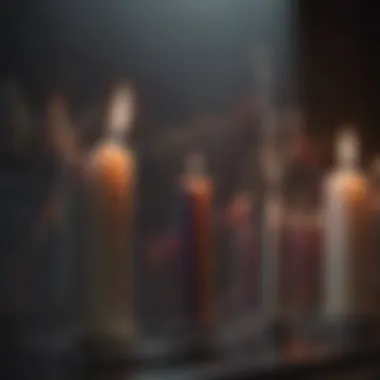Understanding Candle Graphs for Market Analysis


Intro
Candle graphs, often referred to as candlestick charts, serve as powerful visual tools in the realm of trading, particularly when analyzing the tumultuous terrain of cryptocurrencies. They provide immediate insights into market sentiment and price movements over time. By interpreting the relationships between opening and closing prices, along with the highs and lows during specific periods, traders can gauge market conditions that are unique and volatile, making them indispensable in the craft of trading.
Understanding candle graphs is fundamental for both new traders and those with experience seeking to sharpen their skills. This article seeks to unpack the details surrounding these charts, laying out their structure, significance, and utility in various trading strategies. Let's dive into the basics of cryptocurrency fundamentals as a foundation for better grasping the essence of candle graphs.
Understanding Cryptocurrency Fundamentals
Cryptocurrency markets operate on principles distinct from traditional finance, driven by technology and innovation. This section will explore the foundational elements that underpin the world of digital currencies.
Key Concepts of Blockchain Technology
At the heart of cryptocurrencies lies blockchain technology. It's a decentralized ledger that records transactions across multiple computers so that the record cannot be altered retroactively. This aspect ensures transparency and security within the cryptocurrency ecosystem. Understanding how blockchain functions is essential for interpreting market trends effectively.
- Decentralization: Unlike conventional banking systems, cryptocurrencies operate without a central authority, making them resistant to single points of failure.
- Consensus Mechanisms: These are protocols that consider a transaction as valid or invalid based on the system's agreed-upon rules. Proof of Work and Proof of Stake are notable examples.
- Smart Contracts: Automated contracts enabling deals to execute without human intervention, adding a layer of efficiency and trust.
Types of Cryptocurrencies and Their Uses
With thousands of cryptocurrencies available today, each serves unique purposes. Recognizing the differences enhances a trader's ability to use candle graphs effectively. Here are a few noteworthy types:
- Bitcoin: The first and most widely recognized cryptocurrency, largely used as a digital asset and medium of exchange.
- Ethereum: Not just a cryptocurrency, but a platform that supports smart contracts and decentralized applications.
- Litecoin: Often considered silver to Bitcoin’s gold, it aims to make transactions faster and cheaper.
Understanding these different types not only improves market analysis but also allows traders to better predict behavior shown on candle graphs.
Analyzing Market Trends
Market analysis is crucial for making informed trading decisions, especially in the rapidly changing world of crypto. Here, we will delve into the techniques and tools that can aid in recognizing trends which are often illustrated perfectly on candlestick charts.
Tools and Techniques for Market Analysis
There are a variety of tools available that can enhance the process of market analysis, providing traders with additional insights. Some notable methods include:
- Technical Analysis: Involves interpreting charts and price movements to predict future market behavior.
- Fundamental Analysis: Considers external factors such as regulations, economic events, and technological advancements affecting the market.
- Sentiment Analysis: Gauging investor sentiment through social media, news articles, and forums which can heavily influence price movements.
Candlestick patterns often reflect the collective thought process of the market, providing traders insight into potential reversals or continuations.
Identifying Emerging Trends in Crypto Investing
Emerging trends greatly affect market strategies. Candle graphs help traders spot these trends early, which can set them apart when it comes to making profitable decisions. Common trends include:
- Bullish Trends: Indicate rising prices, often characterized by a series of consecutive bullish candles.
- Bearish Trends: Characterized by falling prices, visible through successive bearish candles.
- Consolidation Patterns: When prices remain within a range, making it difficult to predict future moves but insightful for recognizing volatility.
Understanding these fluctuations is key to building a robust trading strategy.
The value of understanding candle graphs goes beyond trading; it's about grasping the overarching market narrative that drives prices and investment decisions.
Understanding Candle Graphs
Candle graphs, or candlestick charts as they are often called, serve as a foundational aspect of market analysis, particularly in trading environments. Their significance lies not only in their visual appeal but also in the wealth of information they convey about price movements, time intervals, and market sentiment. By breaking down this concept, traders—be they seasoned professionals or those just dipping their toes into the market—can gain insights that are crucial for making informed decisions.
At the heart of this article is the aim to demystify these graphical representations. When properly understood, candle graphs enable traders to measure market volatility, recognize trends, and predict potential future movements based on historical data.
Definition and Purpose
A candle graph is a type of chart that represents the price movements of an asset over a specific timeframe. Each candle consists of four critical pieces of data: opens, highs, lows, and closes, commonly abbreviated as OHLC. The main purpose of a candle graph is to visually illustrate how the price of an asset has behaved during that timeframe, providing traders with valuable snapshots of market activity.
The anatomy of each candle aids in assessing the sentiment around a particular asset. For instance, if the close price of an asset is higher than its open, the candle is typically colored green (or white), symbolizing bullish sentiment where buyers are in control. Conversely, when the close price is lower than the open, the candle turns red (or black), indicating that sellers are reigning supreme.
History of Candle Graphs
The roots of candle graphs can be traced back to the 17th century in Japan, purportedly developed by a rice trader named Munehisa Homma. Homma used candlestick charts to analyze the price of rice, ultimately leading to the creation of techniques that would influence trading strategies for centuries to come. This form of analysis went relatively unnoticed outside of Japan for many years.
It wasn’t until the late 20th century that candlestick charts gained traction in the Western world, primarily thanks to the efforts of Steve Nison, who wrote the book "Japanese Candlestick Charting Techniques." This book laid the groundwork for many traders to adopt this method, realizing the potency of visual representation in understanding price patterns.
Today, candle graphs are a staple in technical analysis, employed across various markets, including stocks, commodities, and especially cryptocurrencies. By studying these graphs, traders can quickly ascertain price trends and make decisions that could potentially lead to profitable trades.


Candle graphs not only reflect price movements but also chronicle human emotion and market psychology. They are a lens through which the chaotic nature of trading can be understood, helping traders navigate the often turbulent waters of market fluctuation.
Components of a Candle
Understanding the components of a candle is crucial for anyone venturing into the world of trading, particularly in the volatile landscape of cryptocurrencies. Each cryptographic asset's price movement can be captured vividly through these representations, making it easier for traders to extract meaningful insights. Candle graphs are not just a collection of colorful sticks on a chart; they are a language of their own, narrating the ebb and flow of market sentiment.
Open, High, Low, Close (OHLC)
The Open, High, Low, Close, which is often abbreviated as OHLC, serves as the fundamental building blocks of a candle. Each candlestick reflects a specific time frame and comprises these key price points.
- Open: The price at which the asset begins trading for the time period.
- High: The peak price reached during that time frame.
- Low: The lowest price touched.
- Close: The price at which trading concludes for the set period.
Traders look closely at the OHLC values to assess market trends and volatility. They are particularly useful for determining the overall sentiment of the market: bullish or bearish. For instance, if the close price is higher than the open price, it typically signals upward momentum, whereas a lower close may indicate a downward trend. Therefore, grasping these values can lead to more informed trading decisions.
Body and Wick Explained
A single candle is composed of two components: the body and the wicks. Understanding these parts is essential as they convey vital information about the interplay between buyers and sellers.
- Body: The thick part of the candle shows the range between the open and close prices. The body’s length can indicate the strength of the price movement. A long body suggests strong conviction in the price direction, while a short body indicates indecision.
- Wick: The thin lines extending above and below the body represent the high and low prices during the time frame. The length of these wicks can indicate price rejection or support/resistance level testing. For example, a long upper wick signifies that buyers tried to push prices higher but sellers ultimately took control, while a long lower wick suggests that sellers tried to bring prices down but buyers stepped in to push them back up.
Grasping the dynamics of body and wicks empowers traders to predict potential price reversals or continuations, facilitating better strategic planning.
Color Significance
The colors of the candlestick can carry profound meanings, serving as a visual cue for traders. Typically, a candle is colored according to its closing price compared to its opening price.
- Green (or White): Indicates a bullish candle where the closing price is above the opening price. This reflects a positive market sentiment, suggesting buying pressure.
- Red (or Black): Signifies a bearish candle with the closing price below the opening price, revealing selling pressure.
The significance of color becomes even more important when analyzing trends over time. For instance, in a series of successive candles, observing a pattern of alternating colors could indicate market fluctuations or indecision. Additionally, a cluster of green candles might signify a strong bullish trend, while consecutive red candles could show a consolidating bearish market.
Understanding the implications of candle colors within the broader market context can arm traders with insights that go beyond mere price movements.
"Candles are more than just representations of price; they tell the story of the market's emotional state."
In summary, the components of a candle—open, high, low, close, the body, the wick, and their colors—offer crucial insights into market behavior and sentiment. For traders looking to carve out their niche in the trading realm, grasping these elements is not just beneficial; it’s essential.
Interpreting Candle Patterns
Understanding how to interpret candle patterns is crucial for traders. These patterns serve as visual cues that offer insights into market sentiment and potential price movements. By mastering these interpretations, one can make informed decisions that align with their trading strategies. The beauty of candle patterns lies in their simplicity yet depth; a candle can tell a story. When you know how to read it, you'll see not just the numbers, but the underlying emotions and market forces at play.
Single Candle Patterns
Hammer
The hammer is a distinctive single candle pattern. It’s shaped like the tool after which it’s named, featuring a small body with a long lower wick. The key characteristic of a hammer is its placement. This pattern appears in a downtrend, suggesting a possible reversal. It signifies that buyers are stepping in, pushing the price up after a downward price movement. The hammer is widely regarded as a beneficial choice for traders because it signals potential buying opportunities.
However, it’s not the whole picture. One unique feature of the hammer is that it needs confirmation through subsequent price action; that means traders often look for a bullish candle to follow it. Its advantage is in spotting turning points, but the disadvantage lies in the possibility of false signals. Traders need to keep their eyes peeled and consider other indicators alongside it.
Shooting Star
On the flip side, we have the shooting star which appears at the top of an uptrend. It features a small body with a long upper wick. The key characteristic here is that it indicates selling pressure after a price rise. The shooting star is deemed a popular and beneficial choice for those looking to understand market retracements. As the name suggests, it’s a signal that the price might fall after reaching a high.
A unique feature of the shooting star is that it doesn’t guarantee a price drop; instead, it invites traders to be cautious. The advantage of recognizing this pattern is the early warning it provides. Still, if one trades solely based on this with no confirmation, they might end up with losses.
Doji
The doji is another single candle pattern but is quite different from the hammer and shooting star. Its body is very small, close to zero, indicating indecision in the market. The key characteristic here is that the opening and closing prices are nearly the same, which illustrates a battle between buyers and sellers. The doji serves as a beneficial choice for traders looking for signs of potential reversals or continuation.
One unique feature of the doji is that it reflects uncertainty. When it appears after a strong trend, it may indicate that the trend is losing momentum. However, the doji can also suggest continuation if confirmed by the following candles. The advantage is in recognizing shifts in market sentiment, yet it is often best used in conjunction with other indicators to avoid misinterpretation.
Multiple Candle Patterns
Bullish and Bearish Engulfing
The bullish and bearish engulfing patterns are significant indicators of market sentiment. A bullish engulfing pattern involves a small bearish candle followed by a larger bullish candle, indicating a strong reversal from downwards to upwards. The key characteristic is the engulfing nature; the second candle must completely cover the body of the first. This pattern is popular because it reflects a shift in control from sellers to buyers. Its unique feature is the high potential for price reversals.


Conversely, the bearish engulfing pattern indicates a potential decline. Here, a small bullish candle is followed by a larger bearish one. This suggests that sellers are overpowering buyers. It’s beneficial for traders looking to short the market. However, as with other patterns, these descriptions should be confirmed with additional analysis.
Morning Star and Evening Star
The morning star and evening star are another duo of interesting patterns. A morning star is a three-candle pattern signaling a bullish reversal. It usually begins with a bearish candle, followed by a small-bodied candle, and concluding with a bullish candle that shows strength. The key characteristic is the gradual build-up of bullish momentum. It is considered a beneficial pattern for those looking pursue long positions.
On the other hand, the evening star represents a bearish reversal. This pattern consists of a bullish candle followed by a small body and then a bearish candle that closes below the midpoint of the first candle. This pattern indicates a loss of upward momentum. The unique feature here is its ability to demonstrate shifts in market sentiment dynamically. Both patterns, nevertheless, should be approached with a degree of caution. They are strong indicators but require confirmation from subsequent market behavior.
The mastery of interpreting candle patterns paves the way for smart trading strategies and informed decision-making.
Practical Applications of Candle Graphs
Candle graphs serve as a versatile tool in the toolkit of any trader or investor. Their practical applications go beyond mere visual appeal; they allow for a nuanced understanding of market behaviors, helping traders make informed decisions in highly volatile environments. By examining specific elements and benefits of candle graphs, it's clear why they have gained prominence in today's trading landscape.
Market Trend Analysis
One of the foremost practical applications of candle graphs is market trend analysis. By examining candle patterns, traders can decipher whether a market is bullish or bearish. For instance, a series of green candles may indicate rising prices and an uptrend, while a succession of red candles generally points towards a downtrend. This visual representation allows traders to grasp market sentiment quickly.
Key Considerations:
- The context in which the candles appear matters. A single bullish candle in a long-term downtrend could simply be a dead cat bounce, while several sequential candles of the same color can confirm the trend.
- Always consider the placement of candles within the overall chart. For example, a bullish pattern that forms near support levels can signify stronger momentum.
Identifying Entry and Exit Points
Another crucial application of candle graphs is in pinpointing entry and exit points. A trader who understands the patterns can make informed decisions on when to buy or sell. For example, the formation of a Hammer candlestick followed by confirmation could be utilized as an entry signal, indicating potential upward movement. Conversely, patterns like the Shooting Star might suggest it’s time to exit a position, as they hint at a possible reversal.
Benefits:
- Helps traders create a strategy that is both systematic and based on observable patterns.
- Offers a visual cue for timing trades, reducing emotional decision-making.
Risk Management Strategies
Using candle graphs effectively requires an equal focus on risk management. In dynamic markets, protecting capital is paramount. Candle graphs can signal potential turning points, which inherently aids in adjusting stop losses or taking partial profits. A trader noticing a Doji at a resistance level may choose to tighten their stop loss or exit earlier than initially planned, thus securing profits and minimizing risk.
Strategies to Consider:
- Setting stop-loss orders just beyond the recent high or low indicated by candle formations can reduce exposure.
- Frequent evaluation of patterns allows for adaptive risk management—adjust your trades based on emerging market trends.
"Effective risk management is less about avoiding losses and more about creating a plan that allows for growth while minimizing potential setbacks."
To summarize, the practical applications of candle graphs are indispensable for traders and investors alike. From understanding market trends to pinpointing strategic entry and exit points and implementing risk management strategies, these graphical tools offer a robust framework for informed trading in fluctuating markets.
Integrating Candle Graphs with Other Tools
Integrating candle graphs with various analytical tools can enhance market analysis significantly. As traders sift through market data, relying solely on candle graphs may not suffice. The integration of these graphs with other methods, such as indicators and volume analysis, provides a richer context for making trading decisions. By understanding the interplay of these tools, market participants can discern deeper insights and develop well-rounded strategies.
The main goal here is to illuminate how combining candle graphs with indicators and volume analysis offers a more nuanced view of market dynamics. These relationships can help predict potential price movements, offer entry and exit points, and improve risk management strategies.
Combining Trends with Indicators
Moving Averages
Moving averages are a fundamental tool in market analysis, often employed to smooth out price fluctuations. They help reveal the underlying trend by averaging price over a specified period. Something unique about moving averages is their ability to adapt to recent price data, providing a real-time perspective on market trends.
The key characteristic of moving averages is their simplicity and effectiveness. Traders widely use them because they can identify support and resistance levels. For instance, a simple moving average might help a trader see if a price is trending upwards or downwards, which is vital for making timely decisions. They also work well with candle graphs by highlighting the average price over a designated timeframe, offering a context that can confirm what the candlestick patterns are indicating.
However, there are some downsides. Moving averages can be lagging, meaning they may react late to price changes. This delay could potentially lead to missed opportunities, especially in fast-moving markets like cryptocurrencies, where volatility reigns supreme.
Relative Strength Index (RSI)
The Relative Strength Index (RSI) provides a different angle to market analysis. This momentum oscillator gauges the speed and change of price movements. It typically ranges from 0 to 100 and helps traders identify whether an asset is overbought or oversold. Such insights are invaluable for making strategic decisions about when to enter or exit trades.
The beauty of RSI lies in its ability to provide context for price movements. When used alongside candle graphs, it can indicate if a bullish engulfing pattern, for example, is backed by strong momentum or is just a fleeting spike. It streamlines analysis by filtering out noise, enabling traders to focus on the most significant price action.
Yet, like moving averages, RSI isn’t perfect. One significant consideration with RSI is the chance of false signals. During strong trends, it might indicate overbought or oversold conditions when prices continue to go higher or lower without retracing. This limitation requires traders to use RSI in conjunction with candle graphs carefully to avoid falling victim to misinterpretations.


Candlestick Patterns and Volume Analysis
When analyzing candlestick patterns, incorporating volume analysis can significantly enhance interpretative accuracy. Volume serves as a confirmation tool. A specific candlestick pattern accompanied by high trading volume can validate the strength of that signal. For example, if a bullish pattern appears on the chart and it is supported by increased buying volume, it creates a more compelling case for a potential upward movement.
Conversely, a strong price move on low volume might suggest a lack of conviction and lead traders to question its sustainability. Thus, integrating volume analysis with candlestick interpretations is not just helpful; it’s essential for obtaining a well-rounded view of the market.
The interplay between candlestick formations and volume can help investors safeguard against common traps. By observing how price crosses certain levels with corresponding volume cues, traders can make more informed decisions. This synergy between different analytical tools enriches the trader’s toolkit, providing a more robust framework for navigating the complex world of trading.
Limitations of Candle Graphs
Candle graphs are widely recognized in the trading community for their ability to convey market trends and price movements. However, just like any tool, they come with their own sets of limitations that traders need to be aware of. Recognizing these downsides can enhance one’s analysis and inform better trading decisions. Here, we will discuss the primary limitations of candle graphs, focusing on the risks of becoming overly dependent on them and the potential for misinterpretation.
Over-reliance on Graphs
In the ever-fluctuating world of trading, it's easy to fall into the trap of relying too heavily on candle graphs. While they provide visual representations of price data, an over-reliance can lead to a shallow understanding of market dynamics. Relying exclusively on candle patterns might cause traders to overlook important news events or economic indicators that could drive market movements.
In practice, some traders might say to themselves, "If I see a bullish engulfing pattern, I’m jumping in," without considering the context surrounding that pattern. This can be misleading. Economic reports, political factors, and changes in supply and demand often significantly affect prices.
The takeaway? Always use candle graphs as part of a broader analytical framework rather than a standalone solution. They can surely guide decisions but are not foolproof blueprints.
Potential for Misinterpretation
Candle graphs are open to interpretation. While seasoned traders may see clear signals within a chart, novice traders might misread patterns or fail to grasp the nuances behind them. For instance, a doji candle—often seen as a reversal signal—could be misinterpreted in a trending market if viewed in isolation, without considering the preceding candles.
Additionally, traders may have a tendency to skew their interpretations based on bias. If one is bullish on a particular asset, they might overlook bearish signals in the graph or vice versa. It’s crucial to maintain objectivity while analyzing candle patterns.
To mitigate misinterpretation, traders can consider employing additional indicators or tools alongside candle graphs. Indicators like the Moving Average Convergence Divergence (MACD) or the Relative Strength Index (RSI) can provide further validation to the signals observed in candlestick patterns. This way, they can triangulate data, increasing the likelihood of making more informed trading decisions.
"The market can remain irrational longer than you can remain solvent." – John Maynard Keynes
The Future of Candle Graph Analysis
As we peer into the horizon of candle graph analysis, it's clear that the landscape of trading is on the brink of substantial transformation. The integration of advanced technologies and innovative tools stands to enhance the effectiveness of these visual aids, ensuring traders can navigate the unpredictable waters of financial markets more adeptly. Understanding the future of candle graphs is crucial not only for seasoned investors but also for newcomers in the field. With market dynamics shifting rapidly due to various factors—such as increased volatility and the rise of cryptographic assets—it's imperative to leverage every possible advantage.
Technological Advancements
AI and Predictive Analysis
AI and predictive analysis represent a watershed moment for candle graph analysis. The ability to process vast amounts of historical data and identify patterns is a hallmark of AI technology. By analyzing this information, traders can better forecast future market movements based on prior candle behaviors. A key characteristic of AI-driven predictive analysis is its capacity to learn and adapt, refining its predictions over time based on real-world outcomes.
Moreover, its predictive accuracy is significantly higher compared to traditional methods, which often rely on manual insights. However, some critics caution that over-reliance on AI could lead to missed nuances in market behavior that human traders might recognize. The unique feature of this technology lies in its capability to generate significant insights from data that would otherwise remain obscured. AI's advantage is its relentless nature; it can analyze trends at any time of the day, providing a critical edge in fast-moving markets like cryptocurrencies.
Data Visualization Tools
Data visualization tools are another game changer, offering sophisticated ways to interpret candle graphs. In the digital age, where information overload is a reality, these tools help streamline data analysis. One key characteristic is the ability to create interactive, real-time visualizations that adapt as new data flows in. This immediacy enhances the monitoring of market shifts and enables quick decision-making.
These tools come equipped with features allowing customization of visual elements, providing users with a tailored view of the data that resonates with their trading strategies. However, users must be cautious. The visual allure might sometimes lead to oversimplification of complex data, risking misinterpretations. Balancing visual sophistication with analytical depth is essential in ensuring effectiveness, particularly for intricate data sets.
Integrating Candle Graphs with Blockchain Data
The integration of candle graphs with blockchain data represents an avenue not fully explored. As blockchain technology continues to rise in prominence, connecting the dots between price movements displayed in candle graphs and the transaction data inherent to blockchain can offer profound insights. This linkage can provide transparency, allowing traders to see not only price changes but also the volume and nature of transactions driving those changes.
For example, analyzing price changes alongside specific blockchain events, like forks or large transactions, can arm a trader with context that mere candle patterns cannot provide alone. The integration aids in discerning whether bullish trends are genuinely supported by underlying transaction activity or simply a reflection of speculative interests.
As candle graphs continue to evolve with technological enhancements, traders who embrace these changes will likely find themselves more equipped to tackle the challenges of modern markets. Staying ahead of the curve will require an investment in learning and adapting to new tools and technologies, making the future of candle analysis an exciting prospect forthose keen on this nuanced field.
End
Candle graphs are more than just a pretty picture; they are a window into the complex mechanisms of market dynamics, particularly in trading settings. This article has sought to illuminate not just how these graphs are constructed, but also their profound relevance in deciphering price movements. Understanding candle graphs enhances a trader’s ability to read the market, recognize patterns, and ultimately make informed decisions. The nuances of candle patterns serve as critical indicators for market sentiment, proving invaluable for both new and seasoned traders alike.
Recap of Key Insights
Throughout this exploration of candle graphs, several key insights emerged:
- Foundation of Trading Analysis: The article began with defining what candle graphs are and their purpose. By providing a visual representation of price data, they allow traders to understand market trends quickly.
- Components Breakdown: We delved into the essential components—Open, High, Low, and Close (OHLC)—and how each contributes to the overall picture. The candle's body and wick offer a clear indicator of market movements and sentiment.
- Pattern Recognition: Both single and multiple candle patterns were discussed, including typical formations like hammers and engulfing patterns. Recognizing these formations can aid traders in anticipating market reversals or continuations.
- Practical Trading Applications: The article also addressed how traders can apply these insights to their own strategies, identifying entry and exit points based on trends observed through candle analytics.
- Integration with Other Tools: We covered how candle graphs don’t operate in a vacuum. They can be combined with indicators such as moving averages or volume analysis for a more rounded approach to market analysis.
Final Thoughts on Candle Graphs
In our fast-paced trading environment, the importance of candle graphs cannot be overstated. They demystify the overwhelming noise of market data, allowing investors to make decisions based on solid analysis rather than guesswork. However, it’s crucial to remember that candle graphs are one piece of a larger puzzle.
Traders should be cautious of over-reliance; understanding their limitations is as important as utilizing their benefits. Misinterpretation can lead to missed opportunities or losses, so proper education and practice in reading these graphs are essential.
As we move into an age of technoledgy where AI and data analytics are becoming pivotal in trading, candle graphs might evolve further but their core principles will remain relevant. Thus, as a trader or investor, fostering a keen insight into candle patterns equips you with the tools necessary for navigating the intricate waters of market transactions.















